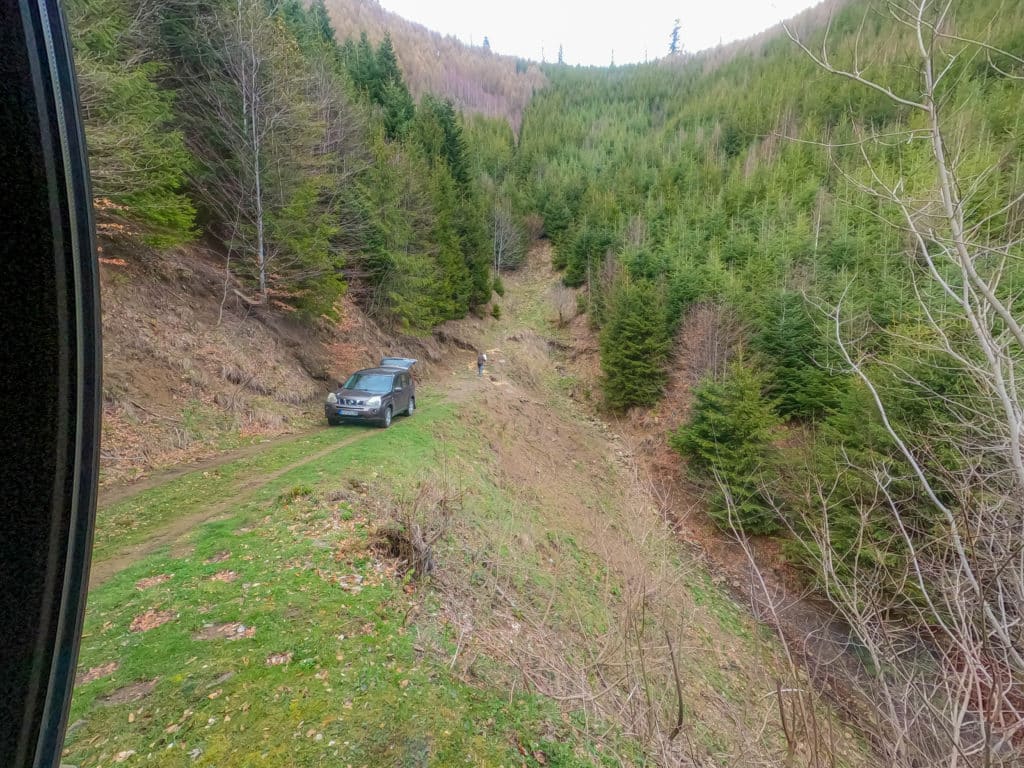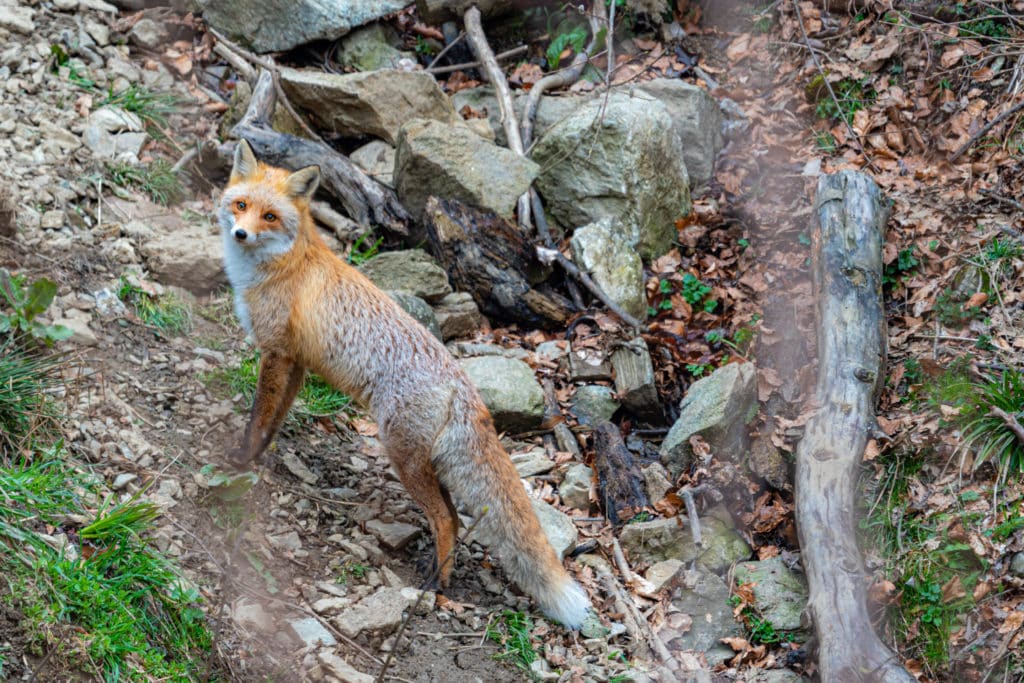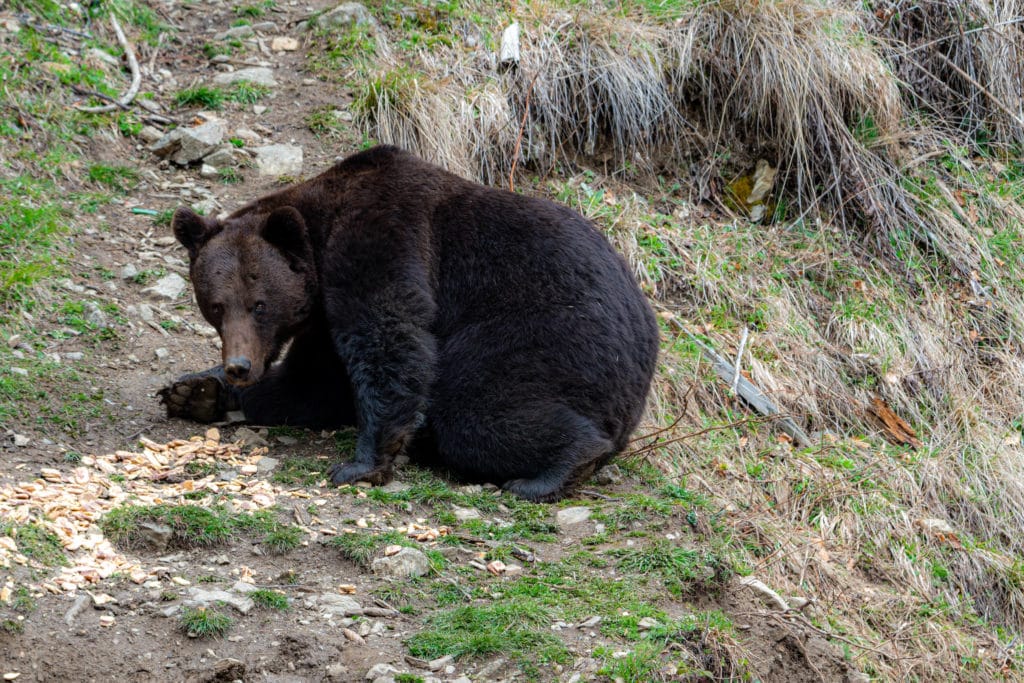Experts estimate that 6,000 Eurasian Brown bears wander the Romanian wilderness. This is 60% of the total European population. Romanian villagers, farmers, shepherds, and outdoor enthusiasts also call these mountains home or spend recreation time here. Romania employs an interesting method of bear management in order to minimize conflict between humans and bears. I learned about this method from my guide Dan Marin, during my Romania bear tour.

Romania bear tour – Mom watching over two cubs
U.S. grizzly bear management
In America, we let our grizzly bears roam freely over huge swaths of land in Montana, Wyoming, Idaho, and Alaska. National Parks and National Forests educate people on methods for safe travel in bear country. They instruct campers to keep a clean camp, provide warnings on recent bear activity, and most importantly, do not feed the bears. If conflict arises, then problem bears are often relocated and sometimes euthanized. Our management system is more complex than this, but this post is not about our management system.
Related: Great Smoky Mountains black bear sightings

Adult male Eurasian brown bear
Romania bear management system
Romania started to feed the bears at a number of remote sites in the mountains during the Communist era. These sites are called bear hides, and Romania has around 70 of them. If the bears have enough food, then they will not need to attack livestock like goats and sheep. Humans are not considered bear food. Only a desperate bear would attack a human for the purpose of predation. These bear hides solve that problem as a desperately hungry bear can go to the bear hide for food. Most bear attacks in Romania occur either when cubs were involved or if a hungry bear was going after livestock and a shepherd or farmer got in the way.
The reason why humans should not feed bears is that they begin to see humans as a source of food. They will then lose their fear of man and that is when attacks can happen. Even though Romania is feeding the bears, the way it is done, the bears do not associate the food with people and have retained their fear of people. Dan told us if you walked outside where they could see you, they would run as fast as they could out of there.

Mother and cub seen from a Romanian bear hide on a Romania bear tour
Wildlife tourism was never the plan when this process began. It is part of their management system. Romania has large sections of wilderness similar to the United States; however, there are a number of people who live in Romania’s national parks unlike in the United States where no private property is allowed inside. This proximity to people and bears make it inevitable that some negative interaction and conflict will develop. This is why the bear feeding plan makes sense.

Eurasian brown bear and cub patiently wait for their turn while a male eats
Romania bear tour
First of all, I would like to note that I am not a wildlife biologist. I am just a travel blogger who loves the outdoors and wildlife. I am not making any statements about how great this system is or if Romania’s is better than the United States plan. The purpose of this blog post is to explain what I saw on my Romania bear tour. I found Transylvania Wolf’s information in Lonely Planet and it looked like the perfect tour for me. One can find other bear tours on Get your Guide and Viator, but I liked the fact that Transylvania Wolf came with an expert licensed wildlife guide. Dan Marin has been studying bears, wolves, lynx and other wildlife and aspects of forestry for over 20 years.

Big adult male brown bear on a Romania bear tour
I emailed Dan and told him I was interested in one of his outdoor tours. He replied within a day and mentioned he had a hiking trip to the Barsa Valley and Zarnesti Gorge available for Tuesday. He also mentioned that he was taking a couple to a bear hide on Monday at 4 p.m and that I could join. I was arriving in Brasov at 1 p.m., so I knew I could easily make the Monday Romania bear tour. When I arrived in Brasov, I grabbed a taxi from across the street and the charge to Zarnesti was 100 lei or a little over 20 usd. There are buses available, but I did not feel I had time to figure out the schedule, where to find the bus, and then how to get to the bus to my hotel room.

Brasov taxi to Zarnesti
Check in at Hora Cu Brazi
Brasov and Zarnesti are both located in the Transylvania region of Romania. Brasov is the biggest city in the area and Zarnesti is the gateway to the Carpathian Mountains and Piatra Craiului National Park. My original plan was to stay in Brasov and come to Zarnesti for my Tuesday tour and then return to Brasov, but since I was coming for a Monday evening tour and a Tuesday morning tour, it made sense to stay in Zarnesti. I was given the option of a city view room or a mountain view. The mountain view option was like ten dollars more, so I went with that. The view from the room was so worth it. There were sheep, roosters, and birds like finches and magpies that I could see from my balcony. There was also a scenic tree covered mountain.

Beautiful mountain view room at Hora Cu Brazi
Romania bear tour begins with pickup
Dan picked us up at the hotel. There was a couple from Spain also on this tour. The drive was about twenty minutes out of the village towards Piatra Craiului National Park. Dan asked if I had ever done any wildlife viewing in Europe. I pondered this question and realized I had never done anything like this in Europe before. When I have been in Europe, it has been only for historical and cultural purposes. I visited Normandy in 1993 to study World War II, and I visited Prague and Poland in 2003 and concentrated on Nazi death camps and enjoyed the beauty of Prague. Last year I visited Greece, and once again focused on history.
Related: Maidanek Death Camp visit a grim reminder of the Holocaust

Front of Hora Cu Brazi hotel where the tour began
Drive to Piatra Craiului National Park
Dan informed us about the bear management system in Romania and about the tour as we left the village behind and the scenery back more rural and then more forested. There were many villagers living in the area, and we had to move around some shepherd dogs on the way to our hide. The dogs are actually part of the plan as they protect livestock from bears. There is even a bear warning system if one comes too close people can call a number and a warning goes out and forest rangers will look for the bear and try and chase it away.
We started to gain some elevation as we left the village behind and then came to a solitary cabin in the middle of the woods. The cabin looked out on a meadow clear cut for the purpose of feeding the bears. The front was a solid pane of glass. We were instructed to move as little as possible, be as quiet as possible, and to not use any camera with a light.

Shepherd dogs help protect flocks from bears and also act as unofficial guards of the road
Bear feeding time on a Romania bear tour
Dan walked outside and up the hill with a big bag of what looked like wood chips. These wood chips were bear food. I believe Dan mentioned they were specially made biscuits. They make the bear food locally and since the government buys quite a bit of it, they are given a deal on the food. Kind of like a bear version of farm to table, but instead farm to mountain side. The food can vary depending on what is available at the local food factory. Dan spread the bear food out and then returned to the cabin.

Honey, it is time to feed the bears – Dan makes 7 bears happy
When it comes to a wildlife sighting tour, there are no guarantees. Dan mentioned they have about an 80% chance of seeing bears on these tours. We did not turn out to be the unlucky 20 as within five minutes a young male sauntered out of the wilderness to get him some grub. Soon after, a female with a cub joined the feast. We even got to see a red fox who kept running back and forth from the woods to the fringe of where the bears were eating. The red fox sighting was at no extra cost.

Red fox at no extra cost

Our first bear on our Romania bear tour was a young male

Another view of the young male and a look at their food
Seven bears seen on our Romania bear tour
Another female with two cubs entered the scene as well as a big male which Dan said was around 15 years old. It was fun to watch the female bear as she was very protective of her cubs as you can imagine. These bear feedings do come at a risk for females as male bears do occasionally kill cubs. She would eat a few pellets then whip her massive nose around in all directions to make sure nothing would sneak up on her and her cubs.

Bears number two and three was this mother and cub
When another bear would arrive while a bear was eating, the eating bear would take off into the woods. They do not take any risks, and leave at the first sound. They might return soon after if they deem the other bear safe or they may wait in the woods for a little longer. There was a couple of times when multiple bears would be feeding at the same time, but they were definitely cautious of each other and most often gave each other space.

Red fox
Is a Romania bear tour cheating?
I enjoy seeing bears in their natural environment. I have been lucky to see black bears in the United States while canoeing, hiking, and driving. It is rare to be able to get a picture of them as they run like hell the minute they note my presence. One might consider this experience as kind of cheating, but in the end it does not really matter. One thing to keep in mind is this is their bear management strategy, and they were doing it even before tourists. It was never meant as a tourist gimmick. The bottom line is I enjoyed the tour and found it fascinating to see Eurasian brown bears in Romania and to hear about the whole process behind the system.

Male bear and a mother with her cub share the feeding area. Mother is sure to keep herself between the male and her cub.
In the Boundary Waters of Minnesota, we were told by a local outfitter that bears can be seen off they highway at a dump. We drove there at dusk and saw six black bears climbing dumpsters to have their way with trash. That I feel was definitely cheating, and I do not count those six bears in my personal bear sighting list. This was definitely more natural and part of a management system that seems to make sense for Romania.

Big claws from adult male brown bear
If this tour is of interest to you, check out Transylvania Wolf. I highly recommend. This tour was sixty Euro per person.
Adventure on!








